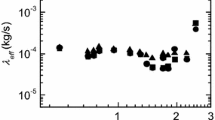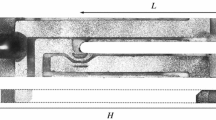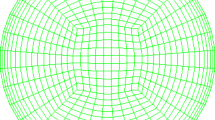Abstract
The paper presents the results of theoretical studies of the transport processes that take place in the newly proposed experiments on study of a vibrating quartz fork in superfluid \(^{3}\hbox {He}\)–\(^{4}\hbox {He}\) mixtures. In addition to known mechanisms of energy loss from a vibrating quartz fork such as first sound radiation or interaction with thermal excitations, two more mechanisms specific for \(^{3}\hbox {He}\)–\(^{4}\hbox {He}\) mixtures are proposed and studied in the paper. The relative contribution of these mechanisms: second sound and effective diffusion, is considered, and experimental conditions under which these mechanisms become effective are discussed.



Similar content being viewed by others
References
D.O. Clubb, O.V.L. Buu, R.M. Bowley, R. Nyman, J.R. Owers-Bradley, J. Low Temp. Phys. 136, 1 (2004)
M. Blažková, D. Schmoranzer, L. Skrbek, Phys. Rev. E 75, 025302-1 (2007)
M. Blažková, M. Človečko, E. Gažo, L. Skrbek, P. Skyba, J. Low Temp. Phys. 148, 305 (2007)
M. Blažková, M. Človečko, V.B. Eltsov, E. Gažo, R. de Graaf, J.J. Hosio, M. Krusius, D. Schmoranzer, W. Schoepe, L. Skrbek, P. Skyba, R.E. Solntsev, W.F. Vinen, J. Low Temp. Phys. 150, 525 (2008)
E.M. Pentti, J.T. Tuoriniemi, A.J. Salmela, A.P. Sebedash, J. Low Temp. Phys. 150, 555 (2008)
E. Pentti, J. Rusti, A. Salmela, A. Sebedash, J. Tuoriniemi, REPORT TKK-KYL-020, 36 (2009)
D. Schmoranzer, M. La Mantia, G. Sheshin, I. Gritsenko, A. Zadorozhko, M. Rotter, L. Skrbek, J. Low Temp. Phys. 136, 317 (2011)
A. Salmela, J. Tuoriniemi, J. Rysti, J. Low Temp. Phys. 162, 678 (2011)
D.I. Bradley, M. Človečko, S.N. Fisher, D. Garg, E. Guise, R.P. Haley, O. Kolosov, G.R. Pickett, V. Tsepelin, D. Schmoranzer, S. Skrbek, Phys. Rev. B 85, 014501 (2012)
R. Blaauwgeers, M. Blazkova, M. Človečko, V.B. Eltsov, R. De Graaf, J. Hosio, M. Krusius, D. Schmoranzer, W. Schoepe, L. Skrbek, P. Skyba, R.E. Solntsev, D.E. Zmeev, J. Low Temp. Phys. 146, 537 (2007)
G.A. Sheshin, A.A. Zadorozhko, E.Y. Rudavskii, V.K. Chagovets, L. Skrbek, M. Blazkova, J. Low Temp. Phys. 34, 1111 (2008)
V. Bakhvalova, V. Chagovets, I. Gritsenko, A.G. Sheshin, J. Low Temp. Phys. (2016). doi:10.1007/s10909-016-1712-8
I.M. Khalatnikov, An Introduction to the Theory of Superfluidity (Addison-Wesley, Redwood City, 1989)
K. Nemchenko, S. Rogova, J. Mol. Liq. 151, 187 (2010)
K. Nemchenko, S. Rogova, J. Low Temp. Phys. 175, 85 (2014). doi:10.1007/s10909-016-1712-8
V. Chagovets, G. Sheshin (Private communication, 2016)
Acknowledgements
Authors cordially thank the researchers from the Institute of Low Temperature Physics, Kharkov Dr. V. Chagovets and Dr. G. Sheshin for private communication about the preliminary results of experiments with a vibrating fork immersed to superfluid \(^{3}\hbox {He}\)–\(^{4}\hbox {He}\) mixtures.
Author information
Authors and Affiliations
Corresponding author
Appendix
Appendix
After Laplace transform of the system (1) and excluding w(r, t), the system of two equations is obtained
where \(\Delta _{\mathrm{r}}\) is Laplacian in cylindrical coordinates, p is a parameter of Laplace transform (inverse time). Here
The system (6) can be transformed to the diagonal form
where \(F=T+\alpha _{1}c\, G=T+\alpha _2c\) are linear combinations, and
The solution of system (5) can be written as
where \(I_{0}\) and \(K_{0}\) are modified Bessel functions.
Substitution of (6)–(8) gives the final result for concentration and temperature
Here \(F_{i}, G_{i}\,(i=1,2)\) are constants depending on p that are found from the boundary conditions and finally give the results (3) of the paper.
Rights and permissions
About this article
Cite this article
Nemchenko, K., Rogova, S. & Vikhtinskaya, T. Heat Transfer in \(^{3}\hbox {He}\)–\(^{4}\hbox {He}\) Mixtures in Cylindrical Geometry. J Low Temp Phys 187, 324–330 (2017). https://doi.org/10.1007/s10909-017-1761-7
Received:
Accepted:
Published:
Issue Date:
DOI: https://doi.org/10.1007/s10909-017-1761-7




